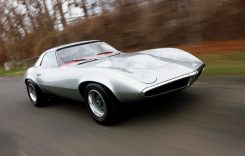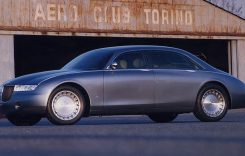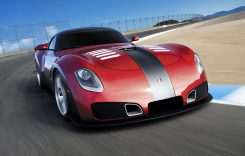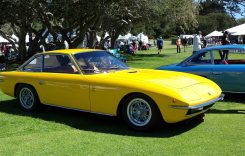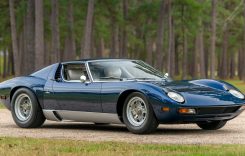Popular with racers and the go-to helmet of many motojournalists, Arai has established a reputation for manufacturing top-shelf helmets. A family-run business that’s in its third generation of ownership, the motorcycle helmets are constructed primarily by hand. Arai says it uses Snell and DOT ratings as baselines, not measures simply to be met. With that in mind, I was eager to test out my first Arai, the Defiant Chopper Helmet along with a Pro Shade System.
The Arai Defiant Chopper Helmet isn’t rounded like other helmets, the egg-inspired shape a deliberate attempt to transfer stress loads evenly in case of a collision. The shape is a little flatter in front so the helmet sits close to your chin. The shape is one of the reasons head-shake is minimized, the helmet ranking high in its resistance to wind buffeting. There’s also a small groove formed in the front spoiler that hangs below the chin bar whose purpose is to reduce buffeting. In the back of the helmet at the base of the neck there’s a small cowl on each side that not only functions as an exhaust vent but is also claimed to help keep a rider’s head stable. While it’s impossible to comment whether this is true or not without a wind tunnel to test the claim, the sum of the measures Arai took to make the helmet aerodynamic work well.
Comfort and the ability to tailor fit to a rider’s head are also admirable traits of the Defiant Chopper Helmet. The cheek pads, a combination of a foam backing plate and padding wrapped in a soft lining, are plush. We tested a size 7 ½ – 7 5/8 helmet and the cheek pads press firm on our cheeks without squishing our face. If you pull the cheek pads out and remove the liner covering them, the top 5mm-thick layer peels off if needed to provide a better fit. The head liner provides a comfortable buffer between your skull and the rigid EPS liner and likewise offers a bit of adjustability as there’s 5mm-thick peel-away temple pads as well. The back of the helmet sees a strip of padding at the base of the skull along with a small, padded neck roll.
Nobody likes helmet funk, but if it’s a hassle to take liners off and on, you’re less likely to take everything out and wash it. Luckily, anything that comes directly in contact with your head comes out, including the washable interior head liner, cheek pads, chin strap covers and neck roll pad. The cheek pads slide into a little groove at the front and pop out quickly and all the liners snap or slide out with ease. Arai states the FCS cheek pads have a new shape, its layers of foam with varying densities and supported by a patented spring. Arai also says the cheek pads are designed to help block wind noise coming in from the bottom of the helmet which we tend to believe because the Defiant Chopper Helmet is fairly quiet compared to other full-face helmets we’ve worn. This is particularly true when all vents and the faceshield are closed, but with the shield up there’s an annoying whistle.
Open up all the vents, though, and the Arai circulates air impressively. The chin vent is fairly large and is two-position adjustable. Click it down one and it’s designed to funnel air up through the top port, the air brushing a rider’s face. Click it down one more and the flow lowers more toward the chin and mouth. The button to adjust the chin vent is a little stiff, though. The helmet also features two brow vents at the top of the faceshield to channel air around the temples. On top of the helmet are two more vents with what Arai calls a “slide-gate” closure. The gates slide forward and can be left half-way or fully open. The tab used to slide the gate is small and sits flush to the vent’s housing and isn’t easy to get a gloved finger on while in motion. Incoming air exits via holes in the side cowls and through three holes in the top “ACR-4” flow-thru exhaust vent on the top-rear of the helmet. The flow-thru exhaust vent likewise has a small tab to open and close it. Bad thing is, the vent housing is held in place solely by a couple of sticky pads, and the housing on our test helmet broke off. We thought it might have happened because of careless airplane bag handlers that have a habit of tossing gear bags with little regard because we didn’t discover it until flying to a press intro (Baggage handlers have cracked top vents on other helmets before). But we didn’t find the housing in our gear bag, and haven’t found it in our office or home. Regardless, for a helmet that costs $675, the vent shouldn’t have popped off as easily as it did since the helmet’s never been dropped or crashed.

We also tested out Arai’s Pro Shade System, a small flip-down, tinted half-faceshield. It attaches to the outer surface of the helmet’s clear faceshield and snaps on easily thanks to the handy quick-release system of the Arai Defiant Chopper Helmet. We did have to take the clear faceshield off first, then snap on the Pro Shade with twin triangle-shaped clips.
Once installed, the Arai Pro Shade is beneficial either up or down. Push it up and it locks into place so wind doesn’t push it around. With it up, the Pro Shade works great as a visor when sun is directly in your face. It doesn’t act like a sail either and increase buffeting. With both the faceshield and Pro Shade up, the annoying whistling we experienced with only the clear shield up decreases. To slide the Pro Shade down, you need to pull out a bit to unlock and lower it. The tent is fairly dark so it can be used in lieu of sunglasses. We appreciate the convenience of not having to swap out shields when the sun goes down, but we do have one gripe about the system. It has two cutouts in the shade which come down so it can slide over the brow vents when it’s in the up position, but the cutouts leave a gap just above our line of sight that isn’t shaded we found to be a little distracting.
Between its thick, red racing stripe and wild line-drawn graphics composed of various parts of a motorcycle, the Arai Defiant Chopper Helmet is a sharp-looking lid. Arai backs up its product with a five-year warranty. Overall it’s a well thought out design, has exceptional venting, is comfortable, and does an admirable job of keeping a rider’s head from jostling around. I haven’t worn any other helmet that allows riders to dial in the fit of the cheek pads without making a separate purchase. But these features come at a hefty price, the Pro Shade System adding another $90, so it is on the upper end of the price scale. But when it comes to protecting your head in a collision, sometimes shelling out extra money for a well-made helmet that meets Snell and DOT mandates and comes backed with a five-year warranty is worth the extra dough.
